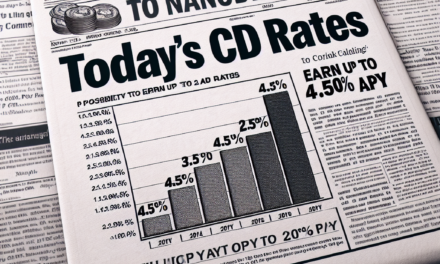“Uncover Hidden Potential: Is This 14% Dividend Stock Your Next Big Win?”
Introduction
Investors seeking high-yield opportunities often turn to dividend stocks as a reliable source of income, especially in volatile markets. While many gravitate towards well-known companies, there are hidden gems that offer substantial dividends and potential for growth. One such under-the-radar stock, boasting an impressive 14% dividend yield, has caught the attention of savvy investors. However, before diving in, it’s crucial to assess whether this stock aligns with your investment strategy and risk tolerance. This introduction explores the key factors to consider when evaluating this intriguing investment opportunity, helping you determine if it fits your financial goals.
Understanding Dividend Stocks: A Beginner’s Guide
Investing in dividend stocks can be an attractive strategy for those seeking a steady income stream, especially in times of market volatility. Among the myriad of options available, some stocks remain under the radar, offering potentially lucrative opportunities for discerning investors. One such stock, boasting a remarkable 14% dividend yield, has recently caught the attention of savvy market participants. Understanding whether this stock is right for you requires a comprehensive grasp of dividend stocks and their role in an investment portfolio.
Dividend stocks are shares in companies that distribute a portion of their earnings to shareholders in the form of dividends. These payments can provide a reliable income source, making them particularly appealing to retirees or those looking to supplement their income. However, not all dividend stocks are created equal. The sustainability of a dividend is crucial, as a high yield may sometimes indicate underlying financial distress within the company. Therefore, it is essential to evaluate the company’s financial health, earnings stability, and payout ratio before making an investment decision.
The allure of a 14% dividend yield is undeniable, yet it is imperative to delve deeper into the company’s fundamentals. A high yield can be a double-edged sword; while it offers substantial income potential, it may also signal that the stock price has declined significantly, possibly due to operational challenges or market skepticism. Consequently, investors must assess whether the company can maintain its dividend payments over the long term. This involves examining the company’s cash flow, debt levels, and overall business model to ensure that the dividend is not only attractive but also sustainable.
Moreover, understanding the industry in which the company operates is vital. Certain sectors, such as utilities and consumer staples, are traditionally known for their stable dividends due to consistent demand for their products and services. Conversely, industries like technology or energy may experience more volatility, impacting their ability to maintain regular dividend payments. Therefore, aligning your investment with your risk tolerance and financial goals is crucial when considering a high-yield dividend stock.
In addition to evaluating the company’s financial health and industry stability, it is also beneficial to consider the broader economic environment. Interest rates, inflation, and economic growth can all influence dividend stocks’ performance. For instance, in a low-interest-rate environment, dividend stocks may become more attractive as investors seek higher yields than those offered by traditional fixed-income securities. Conversely, rising interest rates could lead to increased competition for investor capital, potentially impacting the stock’s price and yield.
Furthermore, diversification remains a key principle in any investment strategy. While a high-yield dividend stock can enhance your portfolio’s income potential, it should not constitute the entirety of your holdings. Balancing your portfolio with a mix of growth and income-generating assets can help mitigate risks and provide a more stable financial foundation.
In conclusion, while the prospect of a 14% dividend yield is enticing, it is essential to conduct thorough research and consider various factors before investing. By understanding the nuances of dividend stocks, evaluating the company’s financial health, and considering the broader economic context, you can make an informed decision about whether this under-the-radar stock aligns with your investment objectives. As with any investment, due diligence and a clear understanding of your financial goals are paramount to achieving long-term success.
Analyzing the Financial Health of High-Dividend Companies
When considering an investment in high-dividend stocks, particularly those that may not be widely recognized, it is crucial to thoroughly analyze the financial health of the company in question. A stock offering a 14% dividend yield can be enticing, especially in a low-interest-rate environment where investors are seeking higher returns. However, the allure of such a high yield should not overshadow the importance of understanding the underlying financial stability and growth prospects of the company.
To begin with, one must examine the company’s revenue and earnings growth. Consistent revenue growth indicates a strong business model and the ability to generate cash flow, which is essential for sustaining dividend payments. It is important to look at the company’s historical performance and future projections to assess whether the growth is sustainable. Additionally, understanding the industry in which the company operates can provide insights into potential challenges and opportunities that may impact its financial health.
Another critical factor to consider is the company’s payout ratio, which is the proportion of earnings paid out as dividends to shareholders. A payout ratio that is too high may suggest that the company is distributing more than it can afford, potentially jeopardizing future dividend payments. Ideally, a company should have a payout ratio that allows for reinvestment in its operations while still rewarding shareholders. A sustainable payout ratio is often a sign of prudent financial management.
Furthermore, evaluating the company’s balance sheet is essential in determining its financial health. A strong balance sheet typically features a manageable level of debt, ample liquidity, and a solid asset base. High levels of debt can be a red flag, as they may indicate financial strain and limit the company’s ability to weather economic downturns. Conversely, a company with low debt levels and significant cash reserves is generally better positioned to maintain its dividend payments even in challenging times.
In addition to these quantitative measures, qualitative factors should also be considered. The company’s management team plays a crucial role in its success, and their track record can provide valuable insights into the company’s future prospects. A management team with a history of making sound strategic decisions and effectively navigating market challenges can inspire confidence in the company’s ability to sustain its dividend payments.
Moreover, it is important to consider the broader economic environment and how it may impact the company’s operations. Factors such as interest rates, inflation, and regulatory changes can all influence a company’s financial health and its ability to maintain high dividend yields. Staying informed about these external factors can help investors make more informed decisions.
In conclusion, while a 14% dividend yield from an under-the-radar stock may seem attractive, it is imperative to conduct a comprehensive analysis of the company’s financial health before making an investment decision. By examining revenue and earnings growth, payout ratios, balance sheet strength, management quality, and external economic factors, investors can better assess whether the stock is a suitable addition to their portfolio. Ultimately, a thorough understanding of these elements can help investors identify high-dividend stocks that offer not only attractive yields but also long-term financial stability.
The Risks and Rewards of Investing in Under-the-Radar Stocks
Investing in under-the-radar stocks can be an intriguing strategy for those looking to diversify their portfolios and potentially reap significant rewards. These stocks, often overlooked by mainstream investors, can offer unique opportunities, particularly when they come with attractive dividends. One such stock, boasting a remarkable 14% dividend yield, has recently caught the attention of savvy investors. However, before diving into this investment, it is crucial to weigh the risks and rewards associated with under-the-radar stocks.
To begin with, the allure of a 14% dividend is undeniable. In a market where traditional dividend yields hover around 2% to 4%, a 14% yield can significantly enhance an investor’s income stream. This high yield can be particularly appealing in a low-interest-rate environment, where fixed-income investments offer limited returns. Moreover, under-the-radar stocks often trade at lower valuations, providing an opportunity for capital appreciation if the market eventually recognizes their potential. This combination of high dividends and potential price appreciation can make such stocks an attractive proposition for income-focused investors.
However, it is essential to consider the risks that accompany these potential rewards. Under-the-radar stocks are often less liquid than their more popular counterparts, meaning they can be more volatile and subject to larger price swings. This volatility can be exacerbated by limited analyst coverage, which can lead to sudden and unpredictable market reactions to news or earnings reports. Furthermore, the high dividend yield may be a red flag, indicating that the company is under financial stress or that the dividend is unsustainable in the long term. Investors must conduct thorough due diligence to ensure that the dividend is supported by strong fundamentals and a healthy cash flow.
In addition to liquidity and sustainability concerns, under-the-radar stocks may also face operational risks. These companies are often smaller and may lack the resources and competitive advantages of larger, more established firms. This can make them more vulnerable to economic downturns, regulatory changes, or shifts in consumer preferences. As a result, investors must be prepared for the possibility of significant fluctuations in the stock’s performance and be willing to accept the inherent risks associated with investing in smaller, less established companies.
Despite these risks, there are strategies investors can employ to mitigate potential downsides. Diversification is key; by spreading investments across a range of under-the-radar stocks, investors can reduce the impact of any single stock’s poor performance on their overall portfolio. Additionally, focusing on companies with strong management teams, solid balance sheets, and a track record of consistent earnings can help identify those with the potential to weather economic challenges and sustain their dividend payouts.
In conclusion, while the prospect of a 14% dividend yield from an under-the-radar stock is enticing, it is crucial for investors to carefully assess the associated risks and rewards. By conducting thorough research and employing prudent investment strategies, investors can potentially capitalize on the unique opportunities these stocks offer. However, they must remain vigilant and prepared for the inherent volatility and challenges that come with investing in less mainstream equities. Ultimately, the decision to invest in such a stock should align with an investor’s risk tolerance, financial goals, and overall investment strategy.
How to Evaluate a Stock’s Dividend Sustainability

When considering an investment in a stock with a high dividend yield, such as the under-the-radar stock offering a 14% dividend, it is crucial to evaluate the sustainability of that dividend. A high dividend yield can be enticing, promising substantial returns on investment. However, without careful analysis, investors may find themselves in a precarious position if the dividend is not sustainable. To assess the sustainability of a stock’s dividend, several key factors must be considered, each providing insight into the company’s financial health and future prospects.
First and foremost, examining the company’s payout ratio is essential. The payout ratio indicates the proportion of earnings paid out as dividends to shareholders. A payout ratio that is too high may suggest that the company is distributing more than it can afford, potentially jeopardizing future dividend payments. Ideally, a sustainable payout ratio should be below 70%, allowing the company to retain enough earnings to reinvest in its operations and weather any financial downturns. In the case of the stock in question, a thorough analysis of its payout ratio will reveal whether the 14% dividend is supported by its earnings.
In addition to the payout ratio, investors should scrutinize the company’s cash flow. Cash flow is a critical indicator of a company’s ability to maintain its dividend payments. Positive and consistent cash flow suggests that the company generates sufficient cash from its operations to cover its dividend obligations. Conversely, negative cash flow or reliance on external financing to pay dividends may signal potential trouble. By evaluating the company’s cash flow statements, investors can gain a clearer picture of its financial stability and the likelihood of sustaining its dividend.
Furthermore, understanding the company’s debt levels is vital in assessing dividend sustainability. High levels of debt can strain a company’s finances, especially if interest rates rise or if the company faces declining revenues. A company with manageable debt levels is better positioned to maintain its dividend payments, even in challenging economic conditions. Therefore, analyzing the company’s debt-to-equity ratio and interest coverage ratio can provide valuable insights into its financial leverage and ability to meet its dividend commitments.
Another important aspect to consider is the company’s growth prospects. A company with strong growth potential is more likely to sustain and even increase its dividend over time. This growth can stem from expanding market share, launching new products, or entering new markets. By evaluating the company’s strategic initiatives and industry position, investors can gauge its potential for future growth and, consequently, the sustainability of its dividend.
Lastly, it is essential to consider the broader economic environment and industry trends. Economic downturns or industry-specific challenges can impact a company’s ability to generate profits and maintain dividend payments. Therefore, staying informed about macroeconomic indicators and industry developments can help investors anticipate potential risks to dividend sustainability.
In conclusion, while a 14% dividend yield may appear attractive, it is imperative to conduct a comprehensive evaluation of the stock’s dividend sustainability. By analyzing the payout ratio, cash flow, debt levels, growth prospects, and external economic factors, investors can make informed decisions about whether this under-the-radar stock aligns with their investment goals and risk tolerance. Through diligent research and careful consideration, investors can identify opportunities that offer both high returns and long-term stability.
The Role of Dividend Stocks in a Diversified Portfolio
Dividend stocks have long been a cornerstone of diversified investment portfolios, offering a blend of income and potential capital appreciation. These stocks provide investors with regular income through dividends, which can be particularly appealing in volatile markets or low-interest-rate environments. The allure of dividend stocks lies in their ability to generate a steady cash flow, which can be reinvested to compound returns or used as a source of income. In this context, an under-the-radar stock offering a 14% dividend yield presents a compelling opportunity for investors seeking to enhance their portfolio’s income-generating potential.
To understand the role of dividend stocks in a diversified portfolio, it is essential to consider their unique characteristics. Dividend-paying companies are often well-established, with stable earnings and a commitment to returning capital to shareholders. This stability can provide a buffer against market volatility, as these companies are typically less susceptible to economic downturns. Moreover, the regular income from dividends can help offset losses in other areas of a portfolio, thereby reducing overall risk.
Incorporating a high-yield dividend stock, such as the one offering a 14% yield, can further enhance the income component of a portfolio. However, it is crucial to assess the sustainability of such a high dividend. A yield that significantly exceeds the market average may indicate underlying risks, such as financial instability or declining business prospects. Therefore, investors must conduct thorough due diligence, examining the company’s financial health, cash flow, and dividend payout ratio to ensure that the dividend is sustainable over the long term.
Furthermore, the inclusion of dividend stocks in a diversified portfolio can also provide tax advantages. In many jurisdictions, qualified dividends are taxed at a lower rate than ordinary income, which can enhance after-tax returns. This tax efficiency, combined with the potential for capital appreciation, makes dividend stocks an attractive option for investors seeking to optimize their portfolio’s performance.
While the prospect of a 14% dividend yield is enticing, it is important to consider the broader context of the investment. Diversification remains a key principle in portfolio management, and relying too heavily on high-yield stocks can expose investors to concentration risk. Therefore, it is advisable to balance high-yield investments with other asset classes, such as growth stocks, bonds, and alternative investments, to achieve a well-rounded portfolio.
In conclusion, dividend stocks play a vital role in a diversified portfolio by providing a reliable income stream and potential for capital growth. An under-the-radar stock with a 14% dividend yield can be an attractive addition, but it requires careful evaluation to ensure its sustainability and alignment with the investor’s risk tolerance and financial goals. By maintaining a diversified approach and conducting thorough research, investors can effectively integrate high-yield dividend stocks into their portfolios, enhancing income potential while managing risk. As always, consulting with a financial advisor can provide valuable insights and guidance tailored to individual investment strategies.
Comparing Dividend Yields: What 14% Really Means
When evaluating investment opportunities, particularly in the stock market, dividend yields often serve as a critical factor for many investors. A dividend yield of 14% is undeniably eye-catching, especially in an era where traditional savings accounts and bonds offer relatively modest returns. However, before diving into such an investment, it is essential to understand what a 14% dividend yield truly signifies and whether it aligns with your financial goals and risk tolerance.
To begin with, a dividend yield is calculated by dividing the annual dividend payment by the stock’s current price. A 14% yield suggests that the company is returning a significant portion of its earnings to shareholders. This can be particularly appealing for income-focused investors seeking regular cash flow. However, it is crucial to consider the sustainability of such a high yield. Often, a yield this elevated may indicate underlying issues within the company, such as financial distress or a declining stock price, which can artificially inflate the yield percentage.
Moreover, comparing this yield to industry standards and the broader market can provide additional context. In sectors where average yields hover around 2% to 4%, a 14% yield stands out as an anomaly. This discrepancy warrants a deeper investigation into the company’s financial health, including its earnings stability, payout ratio, and cash flow. A payout ratio exceeding 100% may suggest that the company is paying out more in dividends than it earns, which is unsustainable in the long term.
Furthermore, it is essential to consider the company’s growth prospects. A high dividend yield might be attractive, but if the company is not reinvesting enough in its operations, it could hinder future growth. This is particularly relevant in industries undergoing rapid technological changes or facing significant competitive pressures. Investors should assess whether the company has a strategic plan to balance dividend payments with necessary investments in innovation and expansion.
Additionally, the macroeconomic environment can influence dividend yields. In times of economic uncertainty or rising interest rates, companies with high debt levels may struggle to maintain their dividend payments. Therefore, examining the company’s debt-to-equity ratio and interest coverage can provide insights into its ability to sustain dividends during challenging periods.
It is also worth considering the tax implications of high dividend yields. Depending on your jurisdiction, dividends may be taxed at a higher rate than capital gains, potentially affecting the net return on your investment. Consulting with a financial advisor or tax professional can help clarify how a 14% dividend yield fits into your overall investment strategy and tax situation.
In conclusion, while a 14% dividend yield can be enticing, it is imperative to conduct thorough due diligence before investing. This involves analyzing the company’s financial health, growth prospects, and the broader economic context. By doing so, you can determine whether this under-the-radar stock aligns with your investment objectives and risk tolerance. Ultimately, a well-informed decision will help ensure that your portfolio remains robust and resilient in the face of market fluctuations.
Case Study: Success Stories of High-Dividend Stock Investments
Investing in high-dividend stocks has long been a strategy favored by those seeking a steady income stream, particularly in times of market volatility. Among the myriad of options available, under-the-radar stocks often present unique opportunities for investors willing to delve deeper into their potential. One such stock, offering an impressive 14% dividend yield, has recently caught the attention of savvy investors. This case study explores the success stories of those who have capitalized on this high-dividend stock, providing insights into its potential benefits and risks.
To begin with, the allure of a 14% dividend yield is undeniable, especially when compared to the average yield of more established stocks. This particular stock, while not widely recognized, has consistently delivered substantial returns to its shareholders. Investors who identified its potential early on have reaped significant rewards, not only from the dividend payouts but also from the stock’s appreciation over time. The company’s robust financial health and strategic positioning in its industry have contributed to its ability to maintain such a high dividend yield, even in challenging economic climates.
Moreover, the success stories of investors who have embraced this stock often highlight the importance of thorough research and due diligence. These investors typically possess a keen understanding of the company’s business model, market position, and growth prospects. By analyzing financial statements, industry trends, and management strategies, they have been able to make informed decisions that align with their investment goals. This level of scrutiny is crucial, as high-dividend stocks can sometimes be indicative of underlying financial distress or unsustainable payout ratios. However, in this case, the company’s strong cash flow and prudent management have alleviated such concerns, providing a level of confidence to its investors.
Transitioning to the broader implications of investing in high-dividend stocks, it is essential to consider the role of diversification in a well-rounded investment portfolio. While the 14% dividend yield is attractive, relying solely on one stock can expose investors to unnecessary risk. Successful investors often balance their portfolios with a mix of high-dividend and growth-oriented stocks, thereby mitigating potential losses and enhancing overall returns. This strategy not only provides a steady income stream but also allows for capital appreciation, catering to both short-term and long-term financial objectives.
Furthermore, the tax implications of high-dividend stocks should not be overlooked. Depending on an investor’s tax bracket and jurisdiction, dividend income may be subject to varying tax rates. It is advisable for investors to consult with financial advisors or tax professionals to optimize their tax strategies and maximize after-tax returns. This consideration is particularly relevant for those who rely on dividend income as a significant component of their financial planning.
In conclusion, the success stories surrounding this under-the-radar stock with a 14% dividend yield underscore the potential benefits of high-dividend investments. By conducting thorough research, maintaining a diversified portfolio, and considering tax implications, investors can effectively harness the power of dividend stocks to achieve their financial goals. While the journey of investing in such stocks requires diligence and strategic planning, the rewards can be substantial for those who navigate the landscape with foresight and prudence. As with any investment, understanding the inherent risks and aligning them with one’s risk tolerance is paramount to ensuring long-term success.
Q&A
1. **What is the stock being discussed?**
– The specific stock is not mentioned, but it is described as under-the-radar with a 14% dividend yield.
2. **What is the dividend yield of the stock?**
– The stock has a 14% dividend yield.
3. **What does “under-the-radar” mean in this context?**
– “Under-the-radar” refers to a stock that is not widely known or followed by mainstream investors or analysts.
4. **What are the potential benefits of investing in this stock?**
– High dividend yield, potential for capital appreciation, and diversification benefits.
5. **What are the risks associated with this stock?**
– Dividend sustainability concerns, market volatility, and potential lack of liquidity.
6. **What factors should be considered before investing in this stock?**
– Financial health of the company, industry trends, management quality, and overall market conditions.
7. **How can an investor determine if this stock is right for them?**
– Assess personal risk tolerance, investment goals, and perform thorough due diligence on the stock and its fundamentals.
Conclusion
When considering whether an under-the-radar stock with a 14% dividend is right for you, it’s crucial to evaluate several factors. First, assess the sustainability of the dividend by examining the company’s financial health, cash flow, and payout ratio. A high dividend yield can sometimes indicate financial distress or an unsustainable payout. Next, consider the company’s growth prospects and industry position to ensure long-term viability. Additionally, evaluate your own risk tolerance and investment goals, as high-yield stocks can be volatile and may not align with conservative investment strategies. Finally, diversify your portfolio to mitigate risks associated with individual stock investments. Conduct thorough research and possibly consult with a financial advisor to make an informed decision.





